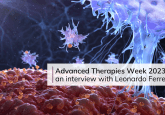Exploring lentiviral vectors: an interview with Natalia Elizalde

 Natalia Elizalde is the Chief Business Development Officer at VIVEbiotech (San Sebastian, Spain), covering business development, technical project management, marketing and communications.
Natalia Elizalde is the Chief Business Development Officer at VIVEbiotech (San Sebastian, Spain), covering business development, technical project management, marketing and communications.
At Phacilitate’s Advanced Therapies Week 2023 (17-20 January 2023; Miami FL, USA), we spoke to Natalia about the challenges in viral vector development and manufacturing, the rapid changes in manufacturing technologies available and how the role of viral vectors in cell and gene therapy will develop in the future.
Please could you explain the advantages of using these vectors?
Lentiviral vectors are being implemented in the development and production of a wide range of therapeutic indications. They can be administered both ex-vivo, such as in CAR-T, TCR and NK-CAR therapies, as well as for transducing some other cells, such as tumor-infiltrating lymphocytes and hematopoietic stem cells. However, lentiviral vectors are now being used increasingly for in vivo gene therapies with very promising results. This is why we selected lentiviral vectors as our gene transfer technology.
What are some of the challenges associated with the development of viral vectors and how are they being overcome?
The first major challenge is that the field needs to develop more productive manufacturing processes. The number of diseases addressed by these therapies are increasing, and therapeutic indications requiring high vector doses are also expanding. We need more cost-effective processes to be able to meet the demands. VIVEbiotech is working on the optimization of different steps of the production process, such as on the producer cell line and on different upstream processing steps.
Secondly, we need purer vector samples. Purity is essential for obtaining more functional vectors that are able to efficiently transduce the final target cells. Additionally, as we mentioned above, we are manufacturing more and more lentiviral vector batches that will be administered in vivo. Regulators are more demanding with the purity levels of these last therapies.
How has the manufacturing processes of lentiviral vectors evolved over time?
It has evolved a lot. Our company has been in the market for eight years now and we have witnessed the rapid improvement and changing of manufacturing technologies. For instance, we use Univercells Technologies´ (Nivelles, Belgium) production platform, which offers a number of advantages. It is a high-content technology which means the productivity per cell is very high or, in other words, fewer cells are needed to produce the same titer and thus purer samples are produced. Moreover, this manufacturing platform offers the possibility of producing intermediate scales that adequate very well with our customers´ diverse requirements. All these characteristics have granted a lot of progress since the beginning of the manufacture of lentiviral vectors.
We will very soon be offering commercial-scale lentiviral vector manufacturing at VIVEbiotech for which we are already working on automation and digitalization to ensure reproducibility.
How do you see the role of viral vectors in the cell and gene therapy industry developing over the next five years?
We expect that a significant number of viral-vector-based therapies will be authorized in the next five years. Indeed, the US FDA expects to approve 10–20 cell and gene therapy products per year by 2025. This should lead to the establishment of more robust and standardized production processes, as happened with some other biologics that were in the field before the viral vectors arrived.
Disclaimer
The opinions expressed in this interview are those of the interviewee and do not necessarily reflect the views of RegMedNet or Future Science Group.
